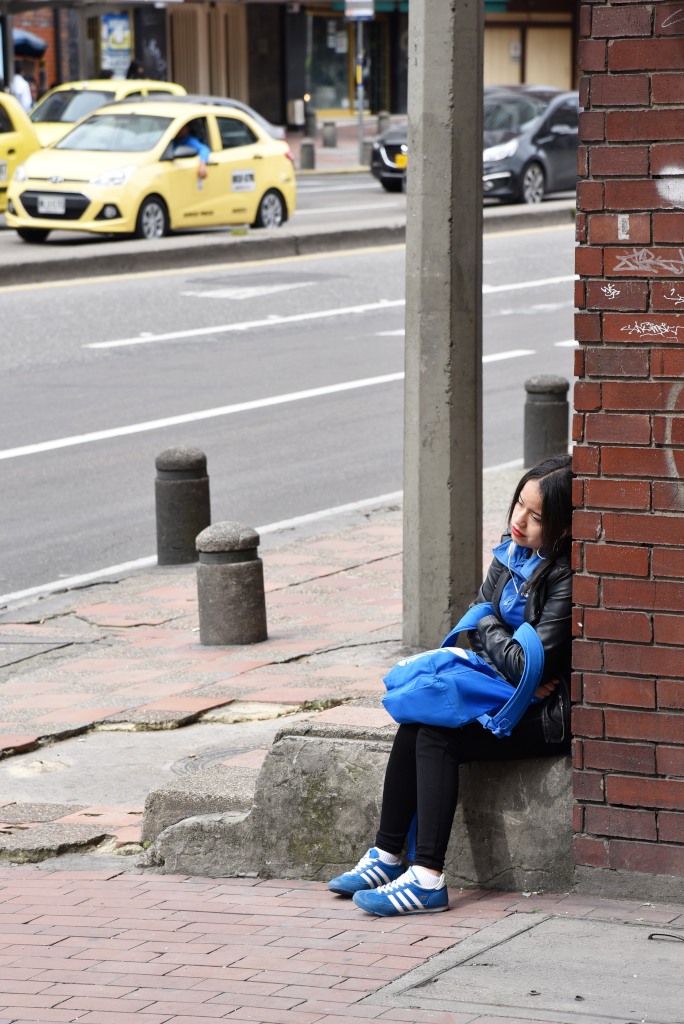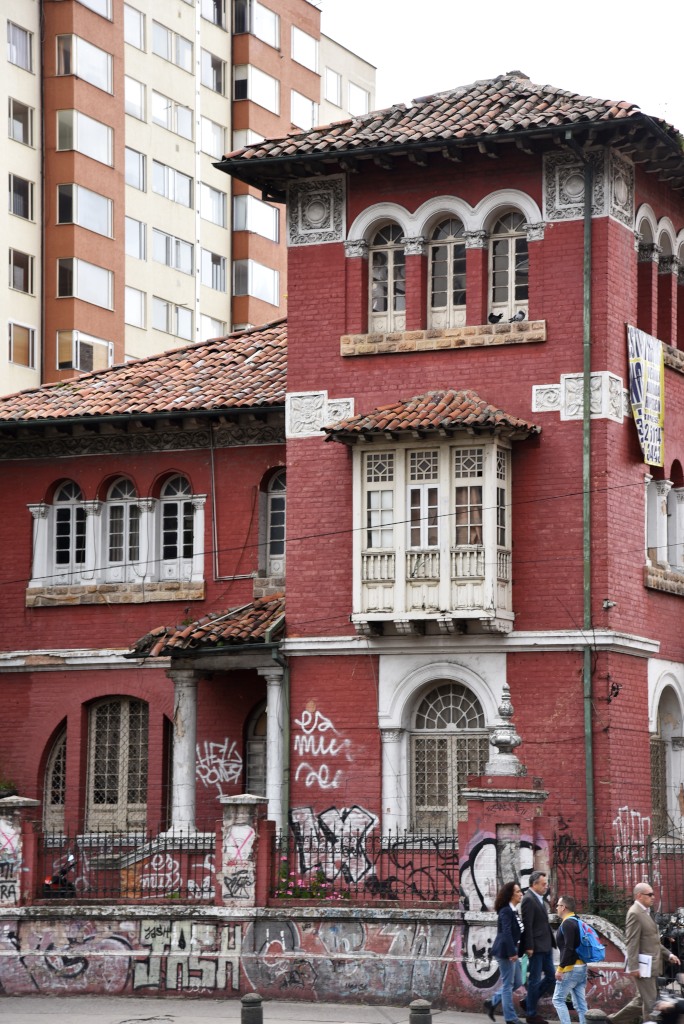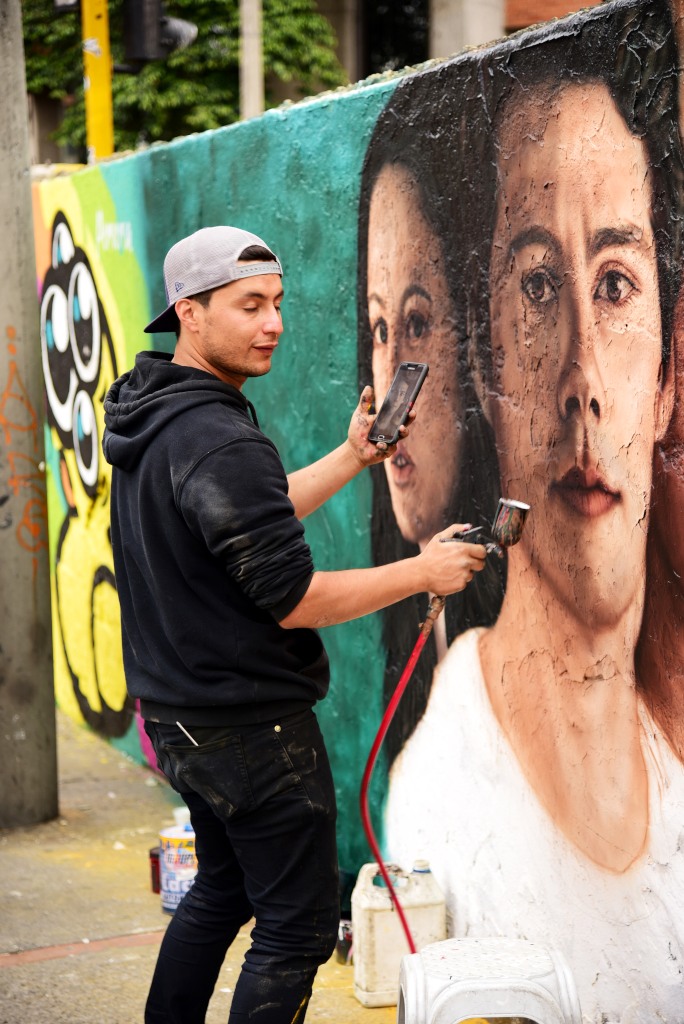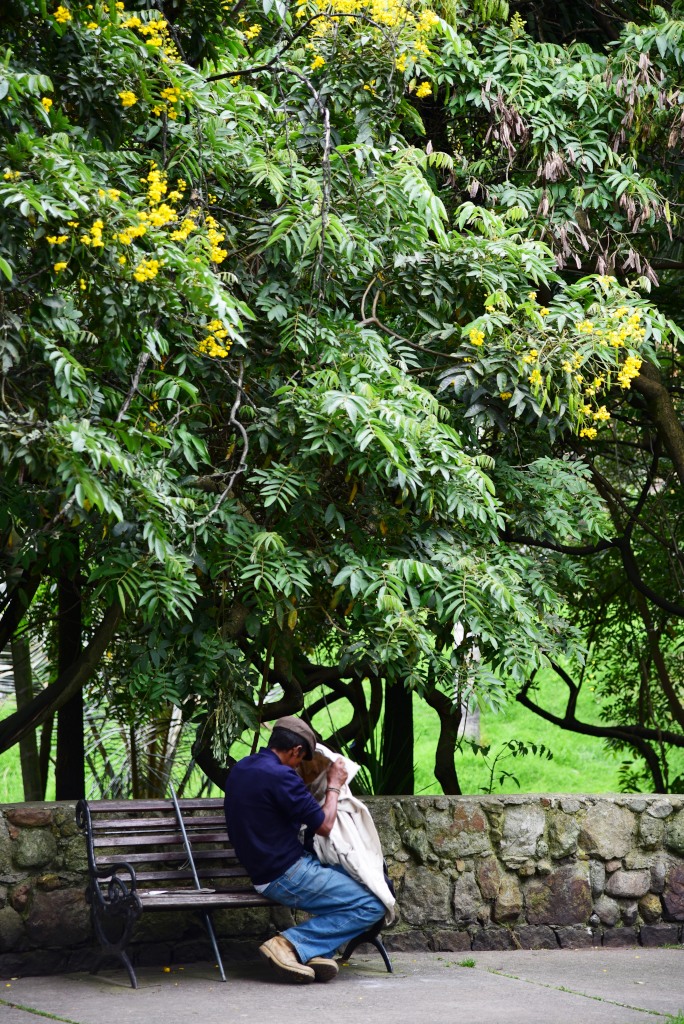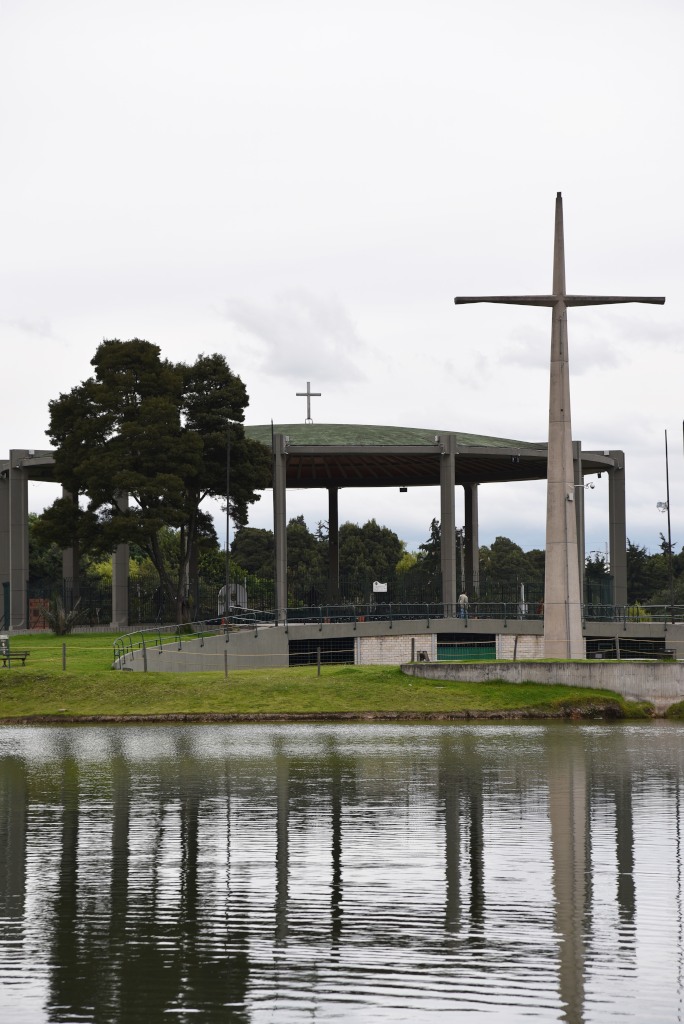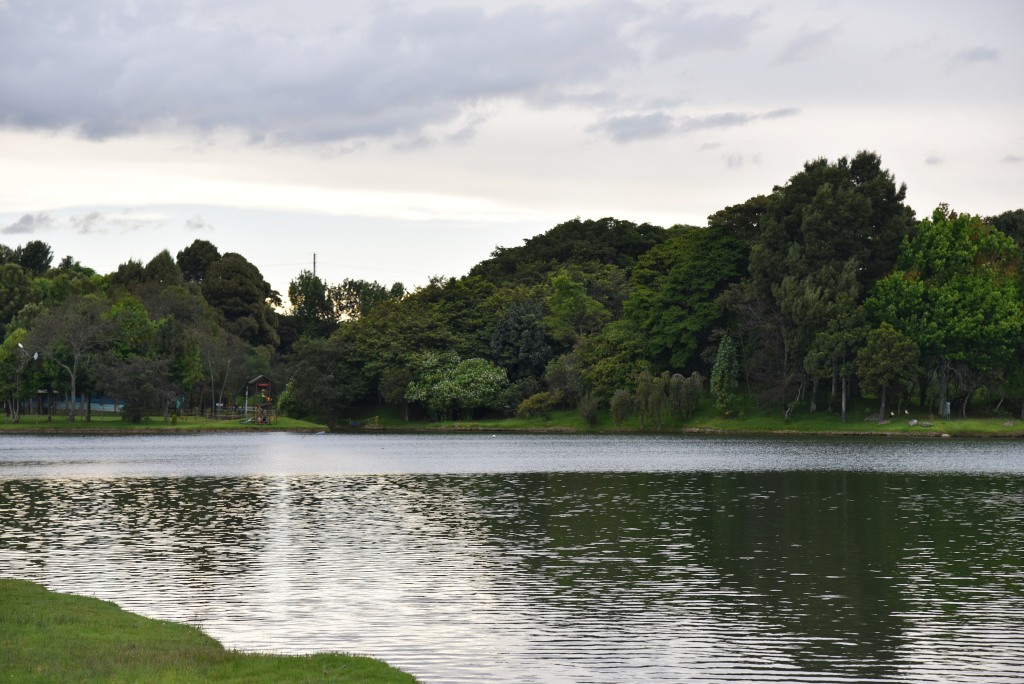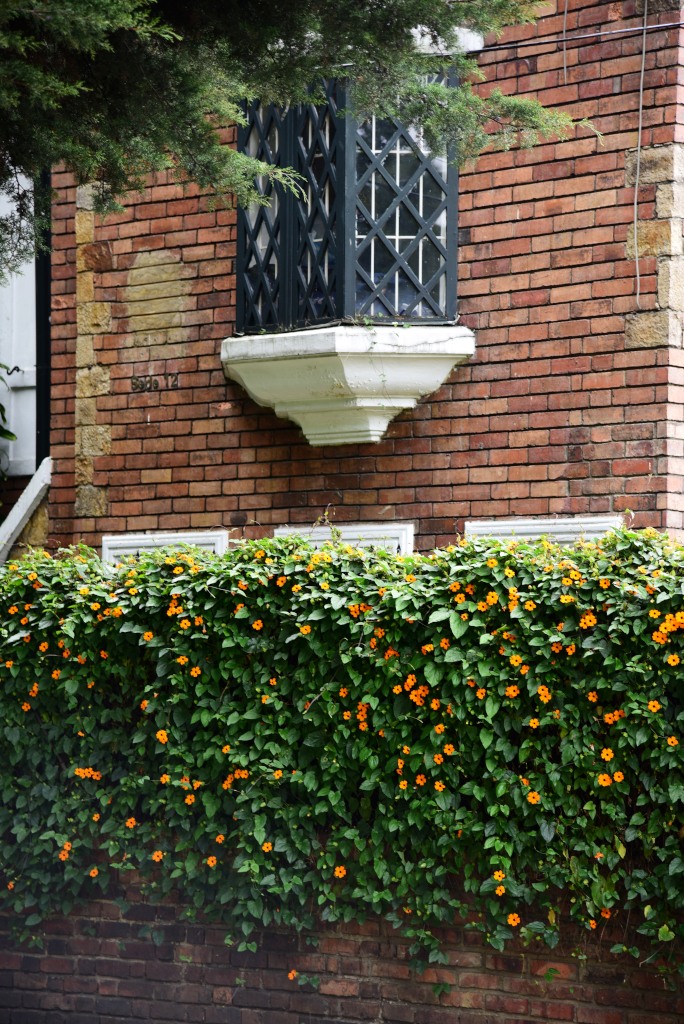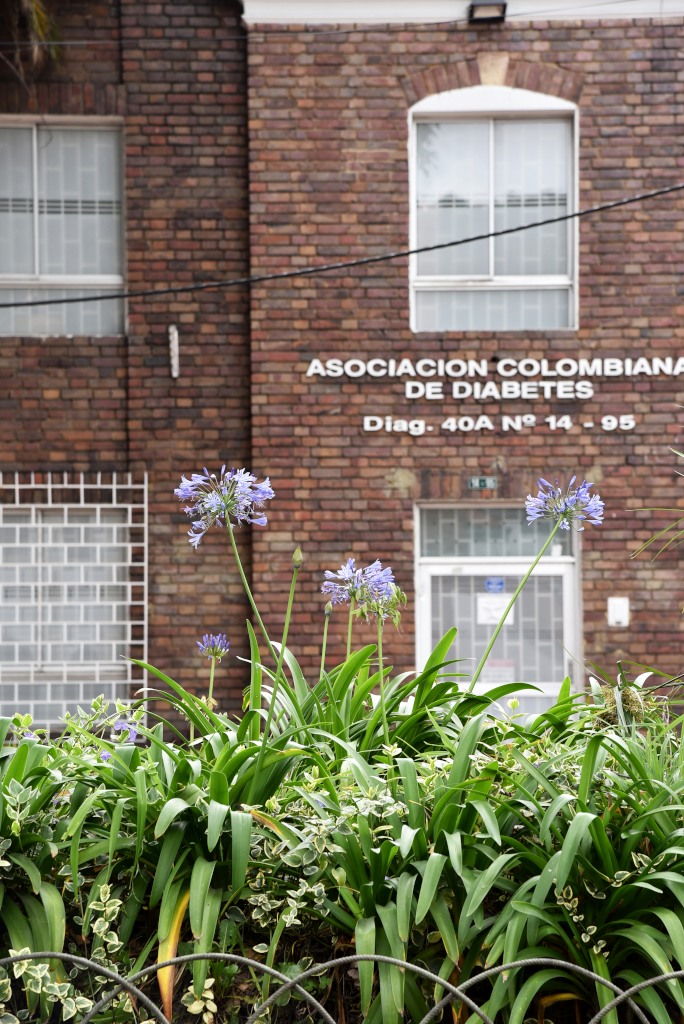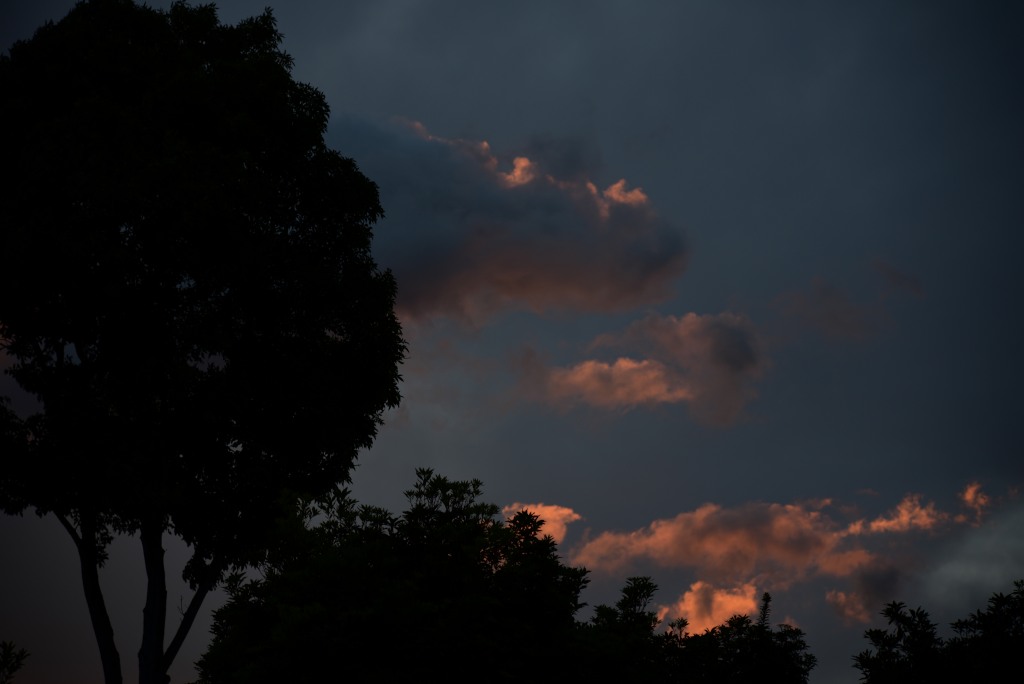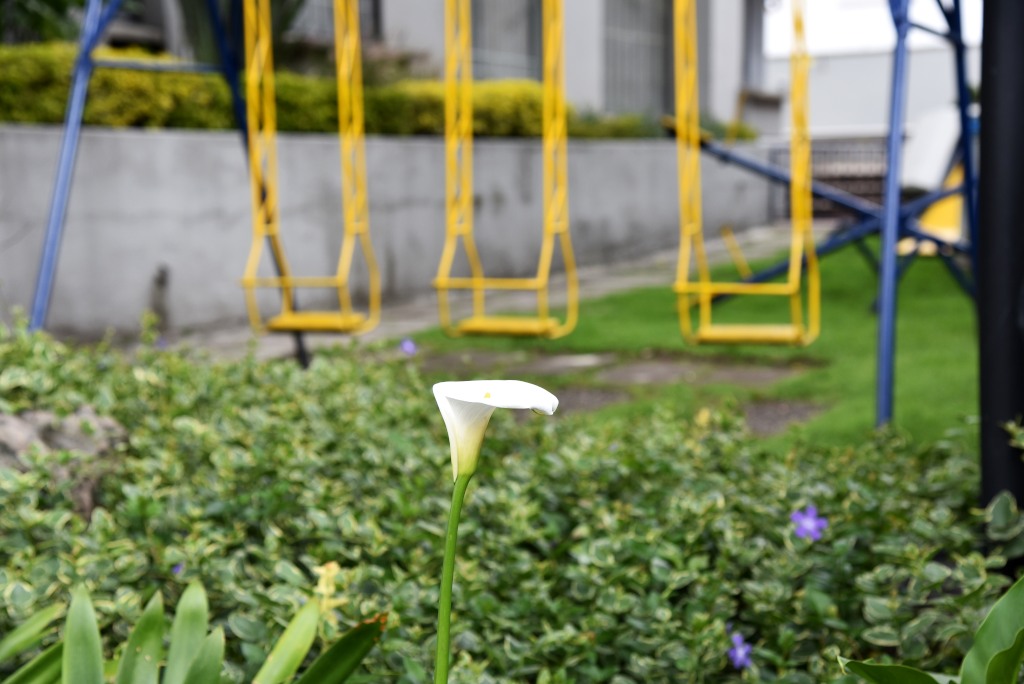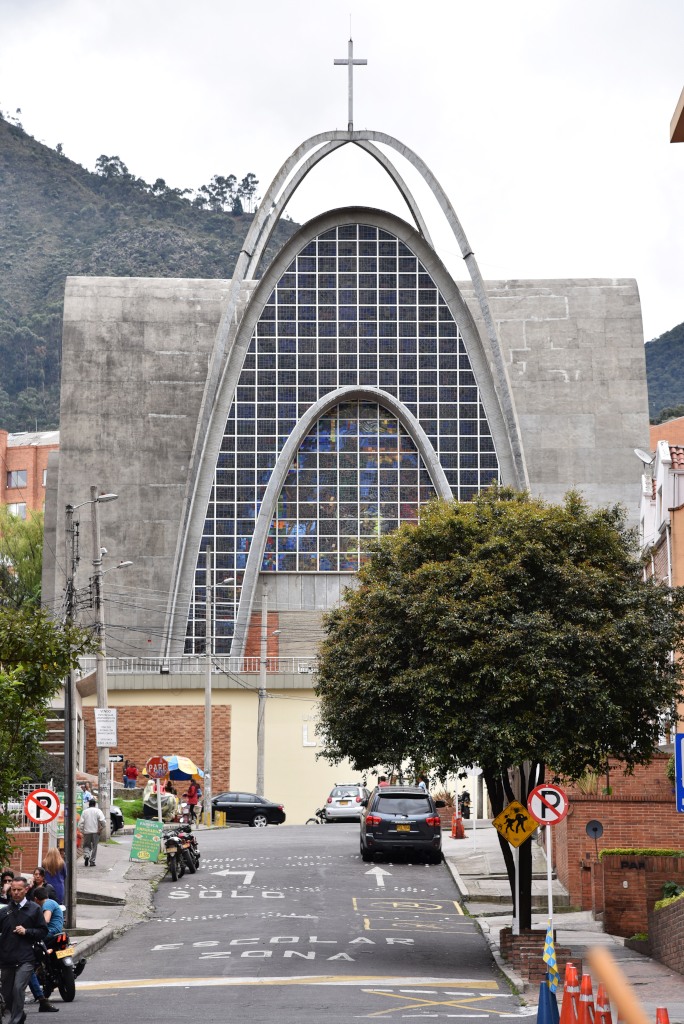January 22nd, 2018
It turns out that while the Carrera 19 I am housed on is middling in nature, the area immediately to the east, heading towards the inner city, becomes much posher as of the next Carrera, with small but perfectly tended floral gardens fronting immaculate Tudor revival townhouses. The roadbeds of Calle 39 are separated by a broad, grassy and tree-lined meridian, through which runs a canal, and along which are occasional beds of exuberant flowers.
It all changes with the morass of traffic, noise and exhaust fumes at Avenida Caracas, but then on the other side, in the southernmost portion of Chapinero rise gleaming office towers, and on the street level office workers in dapper suits scurry to fulfil their day’s commitments, or more likely rush towards the line of smart restaurants lining one side of the street, of a far higher caliber than anything I have seen on the Avenida Caracas.
To the north, the Parque Nacional Olaya Herrera, which provides a lush green space as counterpoint to the hustle below it. But appearances are deceptive, as I have been repeatedly told to not go into the park, as it is poses a risk. Now the paths rising upward among the trees to successive terraces are frequented by the occasional office worker and student, hardly the most threatening environment I could imagine. At nightfall, on the other hand, things could well be different.
I suspect that the sleek modernist structure immediately to the north could the Javeriana university, and in fact it is. Not that the hordes of dapper young locals milling around the streets in front of the building don’t give it away. The facade features two different components, the upper, largely sheer rectangular tiling in shades of brown, and the lower portion glass, fronted by what appears to be heavy vertical louvers.
Tall, narrow and glass-fronted dormers reimagined for this structure jut out from the upper facade, while some of the tiles feature abstract pointillist designs, complicating the visual plane in subtle ways. And somewhat more incongruously, mesh outlines of birds are attached to a metal grid layered over the louvers on the lower portion of the facade. The birds may be more than just decorative, however, intended to deter birds from flying into the building.
Immediately to the north, the student ambience continues, but the nature of the architecture becomes a lot more drab, run-down and depressing. These student establishments cater to the more alternative crowd, which is apparently not the target demographic of the prestigious university to the south. Buildings are livened up with murals and graffiti, often covering entire walls, quite common in much of the city, and considering how drab some of the architecture here is, hardly unwelcome.
The Calles that drop off below Carrera 7 are apparently home to some of the more happening clubs and bars in the city, but based on the what I have observed from some of the streets I have walked through or observed from a distance, I would be happier not visiting during the day, never mind at night time. The streets are long, narrow, run-down, with questionable characters and activities on display even at mid-day. Surely there could be streets and locales in this swath of Chapinero that could be of a less questionable ilk, but as I have been told repeatedly by locals, why bother finding out the hard way.
I thought Chapinero Alto refers to the south of Chapinero, but it probably refers to the residential areas that rise up above Carrera 7 to the mountains. The strip is apparently more exclusive, although while the mid-sized brick and glass towers that comprise much of the zone appear presentable, I see nothing to indicate any great sense of luxury. Although as it goes in Bogota, further to the north the caliber improves.
Meandering along the narrow sidewalk further to the north on Carrera 7, the largely bleak landscape continues, with drab, single or two-level brick buildings, which are redeemed only by occasional swaths of colourful murals and graffiti. But it is certainly much better than the same latitude of Chapinero running along Carrera 13, with its overcrowding, sidewalks stuffed with ambulatory vendors, and run-down shops.
Or perhaps I just see things differently today, as I am getting more familiar with the city every day I spend in the city.
I am always on a lookout for a suitable café for the opportunity to invigorate myself with a good coffee in the appropriate setting. There are occasional cafés on Carrera 7, but the spaces are so claustrophobic as to not warrant a visit. One positive aspect of Bogota is constantly present, however, and that is the local chains that appear to be professionally run, feature good service and excellent food and drinks, such as Cafe Juan Valdez and the Bogota Beer Garden. But I would prefer to frequent independent establishments …
And I strike gold at the Espresso Macondo set inside a spacious taller at the back of a parking area lined with flowering plants, interior seating on couches and tables, jazz playing on the sound system, ample views offered of Chapinero Alto from the outdoor seating area, and best of all, fairly good coffee.
I have been noticing more amenable eating establishments along Carrera 7, and should probably try the next one that seems to offer reasonable home cooking in a comfortable setting. And the San Parillon around Calle 64 fits the bill. A chuleta agridulce de res, accompanied by white rice, a salad with tomato, avacado and tasty dressing, a thick vegetable soup rich in flavour, and endless glasses of what may be cherimoya juice- all for 9,000 pesos!
Reaching the area of Calles in the 60s, the landscape improves, with smarter buildings and shops, services catering to the more affluent, more spacious frontages and better tended gardens, better dressed pedestrians, at this time of day, elderly locals intent on greeting the world with as much dignity as their hobbling figures will allow.
I am intrigued by some of the ancient cars I see in Bogota. It’s not as there is a continuum of older vehicles from different eras, or there are only ancient vehicles, such as in Havana. Most people drive compact new cars, and then very occasionally you see very unusual old models from the 60s and possible early 70s, such a funky Skoda I espy in a side street.
I can’t resist taking photos of the flowers sold from the kiosks on the street. Of course, growing flowers commercially is one of the country’s major export industries, and hardly a healthy one at that. Then again, it’s not as if people have much choice. It’s just nice to see that they are the beneficiaries of their economic output.
I find some of the architecture here unusual, such as the matching Italian-style manor houses built across from each other and defaced with graffiti, with their Romanesque arched windows and gently sloping terracotta roofs.
Further up, I see one of the mural artists in action, applying a large-scale wall painting using paint hoses, using images from his cell phone. I am amazed by the quality of his work, given the tools he is using.
A solid five story Victorian-style brick mansion that occupies the better part of a block, and features discreet but quite regal entrance portals and heavy stone window casings turns out to be the Four Seasons hotel: I am definitely in upper Chapinero!
Heading westward on 70th, unbridled luxury unfolds before me, expansive cafes in glass atriums, extensive cultivated gardens, restaurants set in trendy manors, jet-setting clientele enjoying their torte and capuccino, faux Tudor manors, Jaguars searching for parking, a setting that is lavish, opulent, and not for the rest of the undesirables to the south. And yet very ironically, the prices in these exclusive establishments seem to be not much more than in the tawdry establishments off Avenida Caracas – but maybe I am not looking hard enough. Pricing in general just seems far beyond most peoples’ means …
Not that I need to be ingesting any more coffee or starch, but the Brot bakery and cafe represents the culmination of upper Chapinero, with the look of a renovated brick Victorian townhouse, compact but fecund garden, rear terrace set against a wall of vegetation, and racks of the most exquisite French pastries in the retail area inside. Both the coffee and chocolate bread are very good, however ridiculous as it may be to be indulging yet again.
Crossing Avenida Caracas, I descend into what I expect to be a hell of dingy workshops, run-down buildings, and dodgy characters – but what I actually encounter is nothing of the sort. The area is rich in workshops, but they are much larger than the ones I had wandered through some 20 blocks to the south, and mixed in with somewhat more stately and well-preserved residential architecture, never mind well-maintained eateries serving mostly home-cooked fare, which is itself a very good reason to be here. And just as everywhere else, innumerable bakeries and coffee shops, Colombians obviously being huge consumers of both.
I come upon an area that specializes in bicycles, every manner of bicycle being manufactured, sold, and repaired, on display in the lofty workshops and glass storefronts. Bogotans love for bicycles is in evidence here, especially given that the bicycles on display are to an extent sophisticated racing models, not surprising, considering what I have seen locals riding on the cycle paths with.
Now I reach the penultimate destination of my trip, the Parque Metropolitano Simón Bolívar, or at least so I think. Continuing along the final stretch of talleres dedicated to motorcycles, wrought iron, and car repair, increasing in size as head south, I reach an elaborate pedestrian overpass, constructed of heavy girders with shallowed pitched ramps leading to an arced overpass, which in turn culminates in artfully designed ramps descending in various directions to the other side of Carrera 30, one of the city’s major north-south arteries.
On the other side, a young woman assures me that the entrance to the park is straight ahead, although following a considerable distance along a mesh fence crowned with barbed wire on one side and a continuum of artful graffiti on the other, I come to another overpass, cross, then continue along a grassy meridian, where it becomes apparent I am nowhere near the park.
Indeed, I am following a path parallel to Carrera 30, while the park veers off at a diagonal somewhere to the west. Meandering through the identical apartment blocks that should lead me to the park entrance, I see businesses reflecting a more upscale demographic, including several organic food stores.
At what I take to the be the park entrance, I follow the cobblestone path directly into a group of Policia Nacional in their reflective jackets on bicycles, chattering excitedly while checking their phones. Through the underpass, more of the police officers who look like they are barely out of their adolescence, and then what I take to be the trail that leads deeper into the park – except that it simply arcs right back to the entrance.
My question to a police officer standing by himself on the path as to how I could continue morphs into a longer conversation. Initially he is hesitant to be speaking to a foreigner about policing matters, but then opens up. The reason so many of the Policia Nacional officers are so young is that the Bogota mayor last year asked the federal government last year to fire a large amount if not the bulk of the police, given the degree of ineptness and corruption prevalent. But then given that young police officers are only paid what he alleges to be 700,000 pesos monthly, there is little chance the current crop of police wouldn’t head down the same route.
I simply appreciate the fact that I can be in this park and not risk suffer the depredations of potential muggers, who would be highly unlikely to risk doing anything, given the number of police officers present at regular intervals, irrespective of how inexperienced they may be. After all, they are carrying weapons …
As I speak with him, I see several cordons of young inline skaters being led by a cyclist racing single file along a paved path behind us. One group rushes past, their legs stroking back and forth in unison, then they are gone, and then the next group appears. Engage young people in sports and you will keep them away from less constructive distractions …
Finally, I broach the actual park entrance, which is by means of a parking lot entrance, the path leading immediately to a large lake surrounded by a dense belt of trees. There is on one hand little semblance of wildness to the park, what with the copious man-made distractions, such as benches, elaborate overpasses, rental boats, a jogging track, a much broader stone walkway wrapping around the lake, and even a stark modernist evangelic temple with huge cross.
The colours are matt and dark, what with the late afternoon of a cloudy day setting in. There are very few locals present at the park, a few random stragglers, some romantic couples, and a man teaching his young son how to ride a bicycle. There is very little to catch the eye, and yet the sight of water and relatively fresh, pollution-free air is refreshing.
The long final stretch back to the apartment on this last night in Bogota. I am actually quite lost at this point, given the undulating shape of the park, and although I am exiting where I entered – but I am not really sure where that is on the map. And it’s getting dark, too …
Outside again, the first thing that hits me is the clouds of fumes that belch from the exhausts of the passing buses. I cross the road, taking my chances in the rushing traffic of rush hour, then turn left at the next intersection, turning onto a broad boulevard with very wide central grass meridian – that centres on an undulating bi-directional bike path. Sure, we may be near the university, but in the end effect Bogota has a degree of cycle path infrastructure that would be shocking in most North American cities.
The few people I encounter on the sidewalk are at loss to explain to me how to get back to the Parkway area, except that in reality I am on an almost failsafe route. I just need to follow Calle 53 all the way towards the vicinity of Carrera 19, and weave southward to the area of 39 where my apartment is located.
In the initial stretch running eastward from the entrance of the Parque Metropolitano Simón Bolívar, a residential development of four level apartment buildings continues for some distance, suggesting what would locally be a comfortable middle class sensibility. On the other side of the boulevard, large and brightly lit shops, perfectly maintained, in crass contrast with the dilapidated establishments that crowd the western side of Chapinero.
As prevalent as the bike paths may be, I find it interesting that there is no pedestrian component, despite the very wide grass borders. Pedestrians have to walk on the far less appealing sidewalks, something I have noticed throughout Bogota. It could be that due to the historic sense of insecurity in the city, people will simply not walk anywhere that is at all removed from the public sphere.
A few last photos of the stunning flashes of orange bursting through the clouds prior to nightfall, some of the only real sun on display today. I buy a bag of mandarins from a fruteria, again, spacious, well-lit, orderly, the temperate and tropical produce piled expertly in baskets throughout the establishment.
Onwards eastwards on 53rd – but where is the bridge I was told about? I encounter a pedestrian overpass, but keep walking. Due to the wonders of Bogota signage, at this point I still have no idea that I am actually on 53rd, and as a result I also am not sure where the Universidad Nacional is located.
It later turns out that the university is located to the south of 53rd, on my right as the road arcs to the left. And there it is – the bridge, and not a small one at that – some three lanes on each side, crossing over Carrera 30, which is by appearances a major north-south artery, with some four or five lanes each side, and also one of the Transmilenio arteries.
On the east side of Carrera 30 lies an explosion of retail commerce, big, bright and bold, American and Colombian chain outlets, smaller fast food establishments, a lesser amount of retail, the sidewalk wide and brimming with pedestrians, and in this devoutly middle class paean to consumerism, there is not the slightest hint of the seedy edginess that is ubiquitous in the periphery of Avenida Caracas.
On Carrera 24 I meander southward, the stores and eateries now smaller, but still largely very proper, well-lit, and without a trace of seediness. And despite the fast food nature of many of the outlets, the quality here appears to be much higher than the tawdry, greasy establishments running through Chapinero off Avenida Caracas. (Anyone reading this will have to conclude I have a thing with Avenida Caracas …)
How interesting – and perhaps not surprising – that my impression of the city has sustained a substantial revision from the first day. Having spent the better part of five days on extensive walks through the city, I think it’s safe to say that the immediate corridor around Avenida Caracas is pretty dodgy, at least north of the centre. South of the centre, it’s probably just worse all around anyway, but who knows, I may be wrong.
It occurred to me that I haven’t seen tourists in Bogota, virtually none in fact. There were small numbers in the Museo Botero, as well as on the street running down to the main square in La Candelaria, but the majority of visitors were locals. In five days of wandering around the city I haven’t noticed anyone that wasn’t visibly Colombian.
I finally return to the apartment after a long and heroic walk around the broader centre of Bogota – and there is still no internet at the house. Great! Just what makes me very unhappy. It’s just as well that I didn’t strip my clothes off, as the laptop gets packed away into my daypack, and I am off to find some semi-decent place that is still open, has wifi, and an electric plug.
Naturally, the first few places I visit, including the coffee roaster some four or five blocks to the south, are closed or closing. Happily, there is one place open, small, cozy, one of innumerable cafes that serve coffee and pastries in Bogota, with a very friendly server. The place is open until 9 pm, and can provide the vaunted access to social media that proves a suitable conclusion for the evening …


















